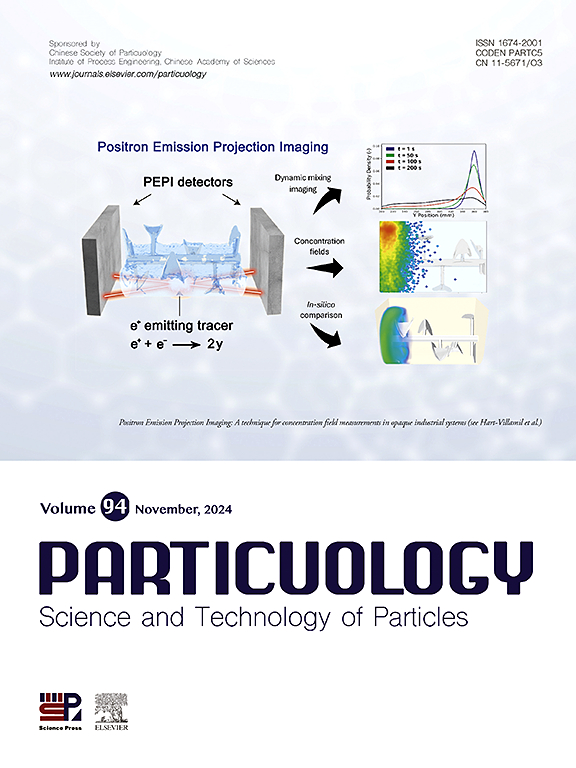Grinding mechanism of wet vertical spiral stirred mill based on DEM-CFD: Role of grinding sphere motion
IF 4.3
2区 材料科学
Q2 ENGINEERING, CHEMICAL
引用次数: 0
Abstract
The grinding sphere is the main ultra-fine grinding medium for the vertical spiral stirred mill, and its motion characteristics have a significant impact on grinding efficiency. A DEM-CFD model of an experimental mill was established, and the accuracy was verified through experiment. The motion characteristics of grinding spheres were systematically analyzed from four aspects: motion trajectory, velocity, force and energy. The results showed that the motion trajectories of the grinding spheres at the cylinder bottom are the shortest, which can be defined as the inert spheres. The trajectory length increases continuously as the height increases in the cylinder, while it increases first and then decreases with the increase of the radial distance. The velocity of grinding spheres near the agitator blade is the highest, while it is lowest at the cylinder wall. By comparing the total, radial, tangential and axial velocities, it was found that its motion mode is mainly tangential motion around the axis, and the axial and radial velocities are very small. The kinetic energy distribution of the grinding spheres is basically the same as the total velocity. The normal collision force of the grinding sphere is 6 times of the tangential collision force, but the tangential collision energy is about 1.4 times of the normal collision energy. Last, five grinding zones were established to characterize the contribution of grinding spheres inside the cylinder to the grinding efficiency. These results will help to understand the grinding mechanism and provide theoretical guidance for the structural design.

基于DEM-CFD的湿式立式螺旋搅拌磨粉机研磨机理:磨球运动的作用
磨球是立式螺旋搅拌磨的主要超细研磨介质,其运动特性对磨矿效率有重要影响。建立了实验轧机的DEM-CFD模型,并通过实验验证了模型的准确性。从运动轨迹、速度、力和能量四个方面系统分析了磨球的运动特性。结果表明:圆筒底部的磨球运动轨迹最短,可定义为惰性球;轨迹长度随着缸内高度的增加而连续增加,随着径向距离的增加,轨迹长度先增加后减小。磨球在搅拌器叶片附近的速度最大,在筒壁上的速度最小。通过对总速度、径向速度、切向速度和轴向速度的比较,发现其运动方式主要是绕轴切向运动,轴向速度和径向速度都很小。磨球的动能分布与总速度基本一致。磨削球体的法向碰撞力是切向碰撞力的6倍,但切向碰撞能量约为法向碰撞能量的1.4倍。最后,建立了5个磨削区来表征缸内磨削球对磨削效率的贡献。研究结果有助于了解磨削机理,为结构设计提供理论指导。
本文章由计算机程序翻译,如有差异,请以英文原文为准。
求助全文
约1分钟内获得全文
求助全文
来源期刊

Particuology
工程技术-材料科学:综合
CiteScore
6.70
自引率
2.90%
发文量
1730
审稿时长
32 days
期刊介绍:
The word ‘particuology’ was coined to parallel the discipline for the science and technology of particles.
Particuology is an interdisciplinary journal that publishes frontier research articles and critical reviews on the discovery, formulation and engineering of particulate materials, processes and systems. It especially welcomes contributions utilising advanced theoretical, modelling and measurement methods to enable the discovery and creation of new particulate materials, and the manufacturing of functional particulate-based products, such as sensors.
Papers are handled by Thematic Editors who oversee contributions from specific subject fields. These fields are classified into: Particle Synthesis and Modification; Particle Characterization and Measurement; Granular Systems and Bulk Solids Technology; Fluidization and Particle-Fluid Systems; Aerosols; and Applications of Particle Technology.
Key topics concerning the creation and processing of particulates include:
-Modelling and simulation of particle formation, collective behaviour of particles and systems for particle production over a broad spectrum of length scales
-Mining of experimental data for particle synthesis and surface properties to facilitate the creation of new materials and processes
-Particle design and preparation including controlled response and sensing functionalities in formation, delivery systems and biological systems, etc.
-Experimental and computational methods for visualization and analysis of particulate system.
These topics are broadly relevant to the production of materials, pharmaceuticals and food, and to the conversion of energy resources to fuels and protection of the environment.
 求助内容:
求助内容: 应助结果提醒方式:
应助结果提醒方式:


